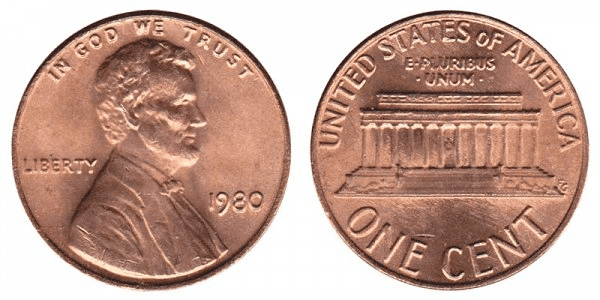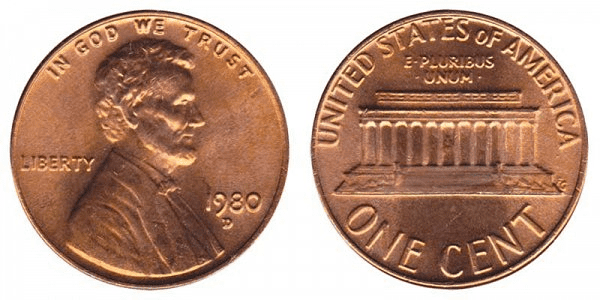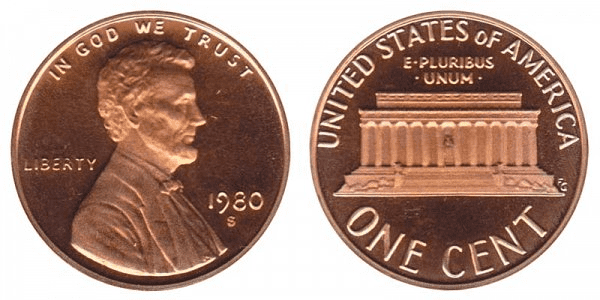What Is Special About The 1980 Lincoln Memorial Penny?
The 1980 Lincoln Penny is regularly encountered in change. Unless it’s a rare mistake coin, the 1980 penny’s worth is determined by its sentimental value. The ability of coins and coin collections to operate as a record of historical events that took place in a certain year is one of its most intriguing features.
They can also serve as a memento for someone who was born in that year or who had an important life event happen in that year.
Victor David Brenner created the commemorative 1980 Lincoln cent’s obverse to correspond with the president’s 100th birthday, and it is nearly identical to the 1909 edition.
Brenner’s initials, V.D.B., which were moved from the reverse in late 1909 and positioned beneath President Abraham Lincoln’s bust in 1918, are the principal variation between the 1980 obverse and the 1909 version.
The year 1980 is displayed to Lincoln’s right, and the phrase “IN GOD WE TRUST” is displayed above the president. The word LIBERTY appears to the president’s left.
Frank Gasparro’s 1959 Lincoln Memorial reverse replaced the 1909 Brenner wheat stalk design that appeared on the 1980 cent.
The Lincoln Memorial’s lower right side bears Gasparro’s initials, FG. The words “ONE CENT” are written beneath the structure and around the rim, while the words “UNITED STATES OF AMERICA” are written all the way around the upper portion of the reverse along the rim.
The motto E PLURIBUS UNUM is inscribed between the words UNITED STATES OF AMERICA and the top of the Lincoln Memorial. The Lincoln cent’s edge is smooth or plain, without any etching or reeding.
The Lincoln Cent was made of copper and nickel before it was replaced with a copper-plated zinc alloy in 1982.
1980 was quite a grim year with Mount St. Helens Erupts in Washington killing 57, the CNN (Cable News Network) began broadcasting on June 1st, and former Beatle John Lennon is shot to death.
Are 1980 Pennies Copper?
Your Lincoln Memorial cent is composed of 95% copper if the date is earlier than 1982. It is made of 97.5% zinc and has a thin copper plating if the date is 1983 or later.
Weighing coins from 1982, when both copper and zinc cents were produced, is the best technique to figure out what metals are inside. While copper-plated zinc coins only weigh 2.5 grammes (+/- 0.100 grammes), solid copper pennies weigh 3.11 grammes (+/- 0.130 grammes).
Early in the 1970s, the cost to create a penny exceeded its face value of one cent due to the rising price of copper. Fortunately, copper’s price fell, and production kept going.
Unfortunately, the United States Mint was compelled to permanently alter the composition of the penny due to the rising price of copper in the early 1980s.
This was done to stop pennies from melting off. In the past, it had been observed in the US that when a coin’s melt value is higher than its face value, people will melt the coins to sell the raw metal and make a profit.
1980 Penny Varieties
1980 P Penny (With No Mint Mark)
Year: 1980
Face Value: $0.01
Composition: 95% copper, 5% zinc
Weight: 3.11 grams (or over)
Diameter: 0.750 in. 19.05 mm
Thickness: 0.0598 inches (1.52 mm)
Edge: Plain
Minted in: Philadelphia
Quantity Minted: 7,414,705,000

photo source: www.usacoinbook.com
1980 D Penny
Year: 1980
Face Value: $0.01
Composition: 95% copper, 5% zinc
Weight: 3.11 grams (or over)
Diameter: 0.750 in. 19.05 mm
Thickness: 0.0598 inches (1.52 mm)
Edge: Plain
Minted in: Denver
Quantity Minted: 5,140,098,660

photo source: www.usacoinbook.com
1980 S Penny
Year: 1980
Face Value: $0.01
Composition: 95% copper, 5% zinc
Weight: 3.11 grams (or over)
Diameter: 0.750 in. 19.05 mm
Thickness: 0.0598 inches (1.52 mm)
Edge: Plain
Minted in: San Francisco
Quantity Minted: 3,554,806

photo source: www.usacoinbook.com
List of errors
Doubled Die Error
The fact that some doubled die penny blunders are worth hundreds or even thousands of dollars is one reason why so many people (even non-collectors) are aware of them. Unfortunately, the majority of doubled dies are not very valuable.
And with the 1980 doubled-die pennies you’re likely to find, that is the case. Only experts look for the majority of 1980 doubled-die Lincoln pennies since they are relatively uncommon.
A 1980 twofold die obverse (heads side) penny with a thicker date and “LIBERTY” inscription, on the other hand, can range in price from $35 to $250+, depending on the coin’s condition.
Repunched 1980-D and 1980-S Pennies
The U.S. Mint coiners hand-punched the mintmarks (“D” and “S”) onto each active die in the early 1980s. It was a procedure with lots of room for error, which occasionally occurred.
As a result of the coiner repunching the mintmark after the initial effort was either misplaced or not oriented correctly — sideways, angled, whatever — some 1980-D and even 1980-S proof penny dies have indications of repunched mintmarks.
The size of the error and how well-known (or sought-after) a certain repunched mintmark error is determine the value of a repunched mintmark in significant part. Repunched 1980 mintmark pennies frequently sell for between $3 and $10.
‘BIE’ Penny
Coin dies are not indestructible. These specifically designed tools that stamp a coin’s design onto a blank ultimately wear out, occasionally becoming fragile and splitting.
These die cracks appear as raised lines, squiggles, or bumps on the struck coins. In the word “LIBERTY,” between the letters “B” and “E,” there is a straight, vertical line that resembles a capital “I” die crack that is specific to Lincoln cents.
Coin collectors love this particular sort of die crack, which is properly labelled a “BIE” variety. A projected price range for an “average” 1980 BIE cent is $5 to $15.
Are There Any Rare 1980 Pennies?
Outside of some of the error variants mentioned above, the value of 1980 pennies comes from exceptionally good condition. In a 2017 auction, the most expensive 1980 penny without a mintmark brought $2,232.50.
At an auction in 2008, the most expensive 1980-D penny brought a whopping $546. The most expensive 1980-S penny was an extraordinarily well-preserved specimen that brought $3,680 in 2003.
How Much Is A 1980 Penny Worth Today?
All Lincoln Memorial pennies made before to 1982 (the year the United States Mint began making these coins in a less expensive copper-plated-zinc variant) are now worth more than their face value since copper has soared in value so significantly.
The Mint switched metals in the early 1980s because it anticipated that the value of the copper inside the coin would increase beyond the coin’s “ONE CENT” nominal value. Therefore, a 1980 penny is worth 2 to 3 cents alone for its copper content.
The prices listed below are for coins designated as Red. (Red Brown and Brown colors will command a lower value)
- Grade AU58 = $4-$6
- Grade MS60 = $4-$4
- Grade MS61 = $4-$6
- Grade MS62 = $5-$8
- Grade MS63 = $6-$10
- Grade MS64 = $11-$19
- Grade MS65 = $15-$25
- Grade MS66 = $26-$44
How Does The Grading System Work?
The Sheldon Scale is used by numismatists to provide a numerical value to coins. The Sheldon Scale goes from poor (P-1) to perfect mint state (P-1) (MS-70). Coins were originally evaluated using words to reflect their condition (Good, Fair, Excellent, Etc.). Unfortunately, coin collectors and dealers had different ideas about what each of these terms represent.
Professional numismatists joined together in the 1970s and established CoinGrading standards. These numismatists now assign grades at key places on the seventy-point scale, using the most regularly utilized numeric points in conjunction with the original adjective grade. The following are the most common coin grades:
-
-
- (P-1) Poor – Indistinguishable and probably damaged; if used, must have a date and mintmark; otherwise, rather battered.
- (FR-2) Fair – Nearly smooth, but without the damage that a coin graded Poor often possesses. The coin must have enough detail to be identified.
- (G-4) Fair – Inscriptions have merged into the rims in some areas, and important elements have been mostly erased.
- (VG-8) Very Good- A little weathered, but all of the primary design elements are visible, albeit faintly. There is little if any, central detail left.
- (F-12) Good – The item is very worn, yet the wear is even, and the overall design details stand out clearly. Rims are almost completely isolated from the field.
- (VF-20) Very Fine – Moderately weathered, with some finer features still visible. The motto or all letters of LIBERTY are readable. Both sides of the coin have entire rims that are separated from the field.
- (EF-40) Extremely Fine – Gently used; all gadgets are visible, and the most important ones are bold. The finer details are bold and clear, however, light wear may be seen.
- (AU-50) Uncirculated – Slight evidence of wear on the coin’s design’s high points; may have contact marks; eye appeal should be adequate.
- (AU-58) Uncirculated Choice – Slight traces of wear, no severe contact marks, almost full mint shine, and great eye appeal.
- (MS-60) Mint State Basal – Strictly uncirculated; no indication of wear on the coin’s highest points, but an unsightly coin with reduced luster, visible contact marks, hairlines, and other flaws.
- (MS-63) Mint State Acceptable – Uncirculated, but with contact scratches and nicks, little reduced shine, but otherwise appealing appearance. The strike is weak to average.
- (MS-65) Mint State Choice – Uncirculated with great mint shine, very little contact blemishes, and exceptional eye appeal. The strike is unusually severe.
- (MS-68) Mint State Premium Quality – Uncirculated with superb luster, no obvious contact marks to the naked eye, and exceptional eye appeal. The strike is quick and appealing.
- (MS-69) Almost Perfect Mint State – Uncirculated with perfect brilliance, a sharp and appealing strike, and extremely good eye appeal. A near-perfect coin with minor imperfections in the planchet, strike, and contact markings (seen only under 8x magnification).
- (MS-70) Mint State Perfect – Under 8x magnification, there are no tiny imperfections discernible; the strike is crisp, and the coin is perfectly centered on a beautiful planchet. Rarely seen on a coin, this coin is bright and whole, with original luster and exceptional eye appeal.
-
Where To Buy Or Sell 1980 Pennies?
Because 1980 Pennies are largely valued as novelty or sentimental coins for those who were born in the year, got married in the year, or had other significant events occur in the year, flea markets, estate sales, and internet marketplaces like eBay are the best venues to get them.
When dealing with unusual or rare coins, such as the 1980 Pennies with flaws or those in great condition, working with reputable coin dealers and auction houses (such as Heritage Auctions) is imperative for added piece of mind.
If you’re not sure whether your penny has a more valuable mint fault or not, you may always ask for help in coin collecting communities.
FAQs
What is the highest price ever paid for a 1980-S penny?
The most expensive 1980-S penny was an extraordinarily well-preserved specimen that brought in $3,680 in 2003.
Where is the mint mark on a 1980 penny?
The mint mark on the 1980 Penny is found on the obverse side of the coin to the right of Lincoln’s chest.
How much is a 1980 red penny worth?
‘Red’ pennies are the most desirable form of Lincoln penny due to their vivid coloring. In the list above you’ll see the average values for pennies designated as ‘red’.



